
An armoured fighting vehicle or armored fighting vehicle (AFV) is an armed combat vehicle protected by armour, generally combining operational mobility with offensive and defensive capabilities. AFVs can be wheeled or tracked. Examples of AFVs are tanks, armoured cars, assault guns, self-propelled artilleries, infantry fighting vehicles (IFV), and armoured personnel carriers (APC).

An anti-aircraft vehicle, also known as a self-propelled anti-aircraft gun (SPAAG) or self-propelled air defense system (SPAD), is a mobile vehicle with a dedicated anti-aircraft capability.
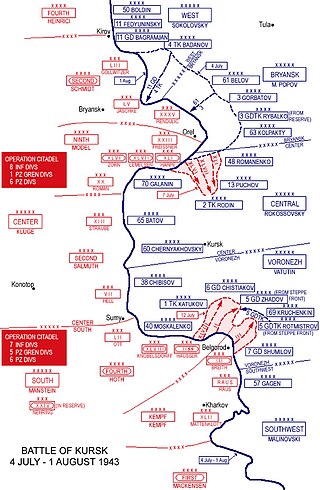
The Battle of Kursk was a major World War II Eastern Front battle between the forces of Germany and the Soviet Union near Kursk in southwestern Russia during the summer of 1943; it ultimately became the largest tank battle in history and resulted in a Soviet victory. It, along with the Battle of Stalingrad several months earlier, are the two most oft-cited turning points in the European theatre of the war preceding the total Allied victory two years later.
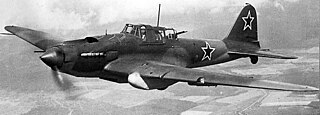
The Ilyushin Il-2 is a ground-attack plane that was produced by the Soviet Union in large numbers during the Second World War. The word shturmovík, the generic Russian term for a ground-attack aircraft, became a synecdoche for the Il-2 in English sources, where it is commonly rendered Shturmovik, Stormovik and Sturmovik.
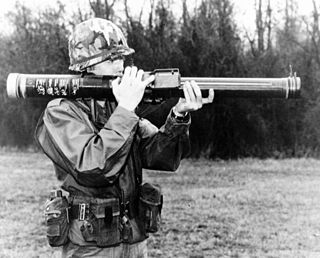
Anti-tank warfare originated from the need to develop technology and tactics to destroy tanks during World War I. Since the Allies deployed the first tanks in 1916, the German Empire developed the first anti-tank weapons. The first developed anti-tank weapon was a scaled-up bolt-action rifle, the Mauser 1918 T-Gewehr, that fired a 13.2 mm cartridge with a solid bullet that could penetrate the thin armor of tanks at that time and destroy the engine or ricochet inside, killing occupants. Because tanks represent an enemy's strong force projection on land, military strategists have incorporated anti-tank warfare into the doctrine of nearly every combat service since. The most predominant anti-tank weapons at the start of World War II in 1939 included the tank-mounted gun, anti-tank guns and anti-tank grenades used by the infantry, and ground-attack aircraft.

The SU-152 is a Soviet self-propelled heavy howitzer used during World War II.
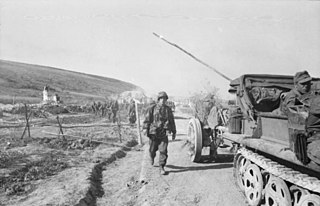
Operation Citadel was the German offensive operation in July 1943 against Soviet forces in the Kursk salient, proposed by Generalfeldmarschall Fritz Erich Georg Eduard von Manstein during the Second World War on the Eastern Front that initiated the Battle of Kursk. The deliberate defensive operation that the Soviets implemented to repel the German offensive is referred to as the Kursk Strategic Defensive Operation. The German offensive was countered by two Soviet counter-offensives, Operation Polkovodets Rumyantsev and Operation Kutuzov. For the Germans, the battle was the final strategic offensive that they were able to launch on the Eastern Front. As the Allied invasion of Sicily began, Adolf Hitler was forced to divert troops training in France to meet the Allied threats in the Mediterranean, rather than use them as a strategic reserve for the Eastern Front. Germany's extensive loss of men and tanks ensured that the victorious Soviet Red Army enjoyed the strategic initiative for the remainder of the war.

An anti-tank gun is a form of artillery designed to destroy tanks and other armoured fighting vehicles, normally from a static defensive position. The development of specialized anti-tank munitions and anti-tank guns was prompted by the appearance of tanks during World War I. To destroy hostile tanks, artillerymen often used field guns depressed to fire directly at their targets, but this practice expended too much valuable ammunition and was of increasingly limited effectiveness as tank armor became thicker. The first dedicated anti-tank artillery began appearing in the 1920s, and by World War II was a common appearance in many European armies. To penetrate armor, they fired specialized ammunition from longer barrels to achieve a higher muzzle velocity than field guns. Most anti-tank guns were developed in the 1930s as improvements in tanks were noted, and nearly every major arms manufacturer produced one type or another.

In anti-tank warfare, an anti-tank mine is a type of land mine designed to damage or destroy vehicles including tanks and armored fighting vehicles.
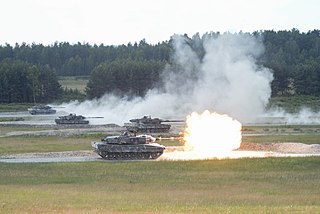
Armoured warfare or armored warfare, is the use of armoured fighting vehicles in modern warfare. It is a major component of modern methods of war. The premise of armoured warfare rests on the ability of troops to penetrate conventional defensive lines through use of manoeuvre by armoured units.

The hedgehog defence is a military tactic in which a defending force creates multiple mutually supporting strongpoints ("hedgehogs") in a defence in depth, designed to sap the strength and break the momentum of an attack. The hedgehogs are designed to be both strong in defence, and thus expensive for an attacker to assault, and capable of mounting counterattacks. The intention is that the attacker will instead bypass them. This will divide his front, expose his forward units to enfilading fire as they pass between hedgehogs followed by attack from the rear when they have passed them, and leave his rear echelons and lines of communication open to counterattack.

Insurgency weapons and tactics (IWAT) are weapons and tactics, most often involving firearms or explosive devices, intended for use by insurgents to engage in guerrilla warfare against an occupier, or for use by rebels against an established government. One type of insurgency weapon are "homemade" firearms made by non-professionals, such as the Błyskawica (Lightning) submachine gun produced in underground workshops by the Polish resistance movement. Another weapon that is part of the conventional military arsenal, but which has been taken up to great effect by insurgents, is the RPG. Two examples of an improvised weapon used by insurgents would be the improvised explosive devices used in Iraq and the Molotov cocktails used against vehicles and tanks. Two tactics used by many insurgents are assassinations and suicide bomb attacks. The latter tactic is used when an insurgent has a bomb strapped to them or in their car, which provides a low-tech way for insurgents to get explosives close to critical enemy targets.

The Battle of Prokhorovka was fought on 12 July 1943 near Prokhorovka, 87 kilometres (54 mi) southeast of Kursk, in the Soviet Union, during the Second World War. Taking place on the Eastern Front, the engagement was part of the wider Battle of Kursk and occurred when the 5th Guards Tank Army of the Soviet Red Army attacked the II SS-Panzer Corps of the German Waffen-SS in one of the largest tank battles in history.
The Panzerkeil was an offensive armoured tactic developed by German Kampfgruppe on the Eastern Front during World War II. The Panzerkeil was developed in response to the Soviet employment of the Pakfront anti-tank gun defence.

A mine flail is a vehicle-mounted device that makes a safe path through a minefield by deliberately detonating land mines in front of the vehicle that carries it. They were first used by the British during World War II.
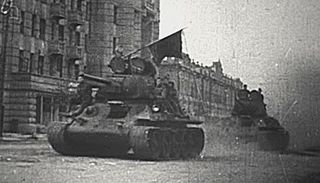
Operation Kutuzov was the first of the two counteroffensives launched by the Red Army as part of the Kursk Strategic Offensive Operation. It commenced on 12 July 1943, in the Central Russian Upland, against Army Group Center of the German Heer. The operation was named after General Mikhail Kutuzov, the Russian general credited with saving Russia from Napoleon during the French invasion of Russia in 1812. Operation Kutuzov was one of two large-scale Soviet operations launched as counteroffensives against Operation Citadel. The Operation began on 12 July and ended on 18 August 1943 with the capture of Orel and collapse of the Orel bulge.
The 67th Guards Rifle Division was formed as an elite infantry division of the Red Army in January, 1943, based on the 1st formation of the 304th Rifle Division, and served in that role until after the end of the Great Patriotic War. It was officially redesignated in the 65th Army of Don Front, in recognition of that division's leading role in reducing the German 6th Army during Operation Ring, the destruction of the encircled German and Romanian forces at Stalingrad. During the following months it was substantially rebuilt while moving north during the spring of the year. The division put up a very strong defense in the Battle of Kursk, facing some of the main elements of Army Group South, and then attacked through the western Ukraine after the German defeat. Along with the rest of 6th Guards Army it moved further north to join 2nd Baltic and later 1st Baltic Front in the buildup to the summer offensive against Army Group Center, winning a battle honor and shortly after the Order of the Red Banner in the process. During the rest of 1944 it advanced through the Baltic states and ended the war near the Baltic Sea, helping to besiege Army Group Courland in 1945. The 67th Guards was disbanded in 1946.

A main battle tank (MBT), also known as a battle tank or universal tank, is a tank that fills the role of armour-protected direct fire and maneuver in many modern armies. Cold War-era development of more powerful engines, better suspension systems and lighter composite armour allowed for the design of a tank that had the firepower of a super-heavy tank, the armour protection of a heavy tank, and the mobility of a light tank, in a package with the weight of a medium tank. The first designated MBT was the British Chieftain tank, which during its development in the 1950s was re-designed as an MBT. Throughout the 1960s and 1970s, the MBT replaced almost all other types of tanks, leaving only some specialist roles to be filled by lighter designs or other types of armoured fighting vehicles.
The 73rd Guards Rifle Division was reformed as an elite infantry division of the Red Army in March 1943, based on the 2nd formation of the 38th Rifle Division, and served in that role until after the end of the Great Patriotic War.
The 78th Guards Rifle Division was reformed as an elite infantry division of the Red Army in March 1943, based on the 1st formation of the 204th Rifle Division, and served in that role until after the end of the Great Patriotic War.
















